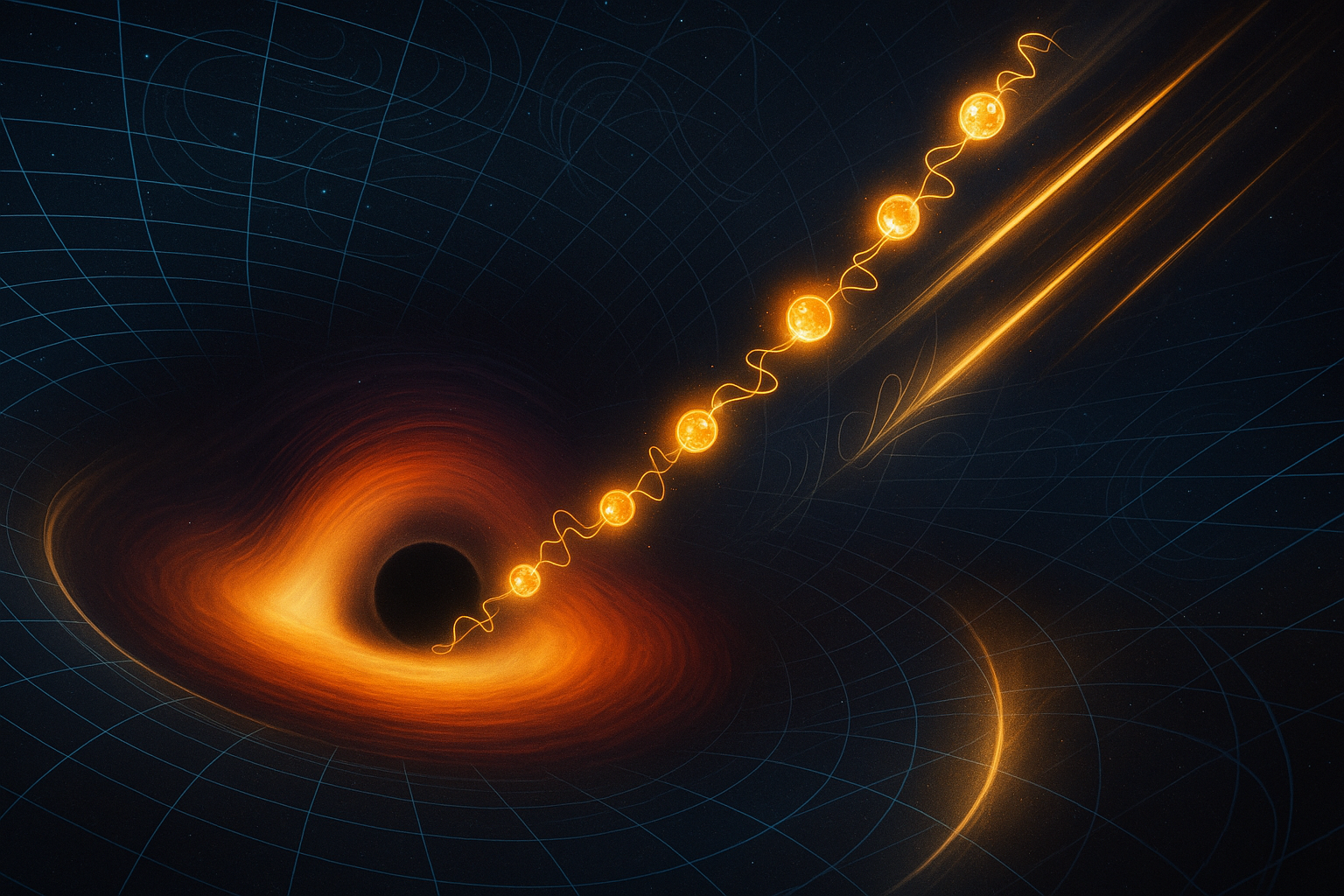

When we picture a black hole, we usually imagine a one-way trap: anything that ventures too close is swallowed forever, and nothing, not even light, can escape. Yet for nearly 50 years, theoretical physics has been telling us a stranger story. Thanks to quantum effects, black holes can glow, radiating faint heat into space.
In a new study published in The European Physical Journal C, Reggie C. Pantig (Mapúa University) and Ali Övgün (Eastern Mediterranean University) show that this radiation can carry sharp fingerprints of new physics beyond Einstein’s theory of gravity. Their work, “Acceleration radiation from derivative-coupled atoms falling in modified gravity black holes,” develops a general framework for how “idealized atoms” radiate as they plunge into black holes that depart from standard General Relativity. (SpringerLink)
From Hawking and Unruh to “acceleration radiation”
Stephen Hawking’s famous calculation in the 1970s revealed that black holes are not completely black: quantum fluctuations near the event horizon make them emit a tiny thermal glow, now called Hawking radiation. At roughly the same time, Bill Unruh showed that a constantly accelerating observer in empty space would also perceive a warm bath of particles—the Unruh effect.
To make these ideas concrete, physicists use a simple thought-experiment device: the Unruh–DeWitt detector. Picture it as a tiny two-level atom flying along some path. If the surrounding quantum field looks “excited” in that frame, the atom can jump from its ground state to an excited state, effectively registering particles where another observer might see vacuum.
In recent years, Marlan Scully and collaborators recast this problem in the language of quantum optics, treating atoms falling into a black hole as a kind of cosmic laboratory laser. Even when the atom follows a free-fall path with no ordinary force acting on it, it still experiences what the authors call “acceleration radiation” because it is accelerating relative to the field modes that define the vacuum for a distant observer. (arXiv)
A more sensitive atom: derivative coupling
Most previous studies assumed a very simple interaction: the atom couples directly to the value of the quantum field at its location. Pantig and Övgün instead focus on a more realistic possibility: the atom couples to the gradient of the field, essentially to how the field changes in space and time along its trajectory.
This “derivative coupling” is analogous to feeling ripples on a lake not by measuring the water level itself, but by sensing how quickly it rises and falls. In many effective field theories, forces are carried not by raw potentials but by their derivatives—think of electric and magnetic fields arising from changes in the electromagnetic potential.
Technically, the authors model the atom as a two-level system with a characteristic energy gap and let it fall radially into a generic, static, spherically symmetric black hole. Using time-dependent perturbation theory, they derive a compact formula for the probability that the falling atom gets excited and emits a photon. All the details of the gravitational background are encoded in a single function describing the black hole geometry. (arXiv)
The key new ingredient introduced by derivative coupling is a geometric prefactor that becomes very large near the horizon. This means the detector is especially sensitive to the violent stretching and squeezing of quantum fluctuations in the near-horizon region, where spacetime curvature is extreme.
Testing quantum gravity ideas: the EUP black hole
To show how their general formula works, Pantig and Övgün apply it first to a black hole inspired by the Extended Uncertainty Principle (EUP). The EUP is a proposed modification of Heisenberg’s uncertainty relation that becomes important on very large length scales, potentially linked to cosmology. In the black-hole context, it slightly changes the relation between mass and horizon radius, effectively giving supermassive black holes a slightly different size and temperature than in standard General Relativity. (arXiv)
The authors find that a derivative-coupled atom falling into this EUP black hole radiates with a perfectly thermal spectrum, with a temperature that exactly matches the EUP-modified Hawking temperature. In other words, even with a more complex interaction and a quantum-corrected geometry, the near-horizon radiation still behaves like that of an ideal hot body.
This result reinforces the idea that the thermal character of black-hole radiation is remarkably robust. Change the details of the interaction, change the underlying gravity theory—if the object still behaves like a black hole with a horizon, the falling atom still “feels” a thermal bath.
Breaking Lorentz symmetry: Bumblebee gravity with a monopole
The second testbed is a far more exotic spacetime: a black hole in Ricci-coupled Kalb–Ramond Bumblebee gravitywith a global monopole. In Bumblebee models, a vector field acquires a nonzero value throughout spacetime, spontaneously breaking Lorentz symmetry—the rule that physics looks the same for all observers moving at constant speed. Global monopoles, meanwhile, are spherical topological defects that could have formed in the early universe, carving out a tiny deficit angle in space. (arXiv)
In this combined model, the effective gravitational potential around the black hole is modified by both the monopole and the Lorentz-violating vector field. Pantig and Övgün show that the acceleration radiation from the falling, derivative-coupled atom is still thermal, but now the effective temperature depends directly on the parameter that measures Lorentz violation.
Crucially, the temperature extracted from the atom’s radiation agrees with the Hawking temperature computed from the black hole’s geometry itself, at least to leading order in the deviation from General Relativity. That match is a powerful consistency check: a purely local quantum-optics calculation reproduces a global thermodynamic quantity of the spacetime.
A built-in “quantum friction” and boosted entropy
One of the most striking findings of the paper is how much stronger derivative coupling can make the radiation. Near the horizon of a standard Schwarzschild black hole, the authors show that the excitation probability for the derivative-coupled atom is enhanced by roughly a factor of four compared to the usual minimal coupling case.
Because the rate of emitted photons and the associated entropy flux scale with this probability, the entropy carried away by the radiation is significantly larger for derivative coupling. The authors interpret this as a kind of quantum friction: as the atom accelerates relative to the field modes, it “rubs” more effectively against the quantum vacuum, exciting more modes and generating more disorder. (arXiv)
This has interesting implications for how information and entropy might be exchanged between infalling matter and the black hole’s surroundings. It suggests that the detailed form of the matter–field interaction could slightly modify the effective link between horizon area and emitted entropy—an idea that may feed into ongoing debates about black-hole information and quantum gravity.
A new probe of near-horizon physics
Although the actual signals predicted in this work are far too tiny to detect with current telescopes, the conceptual payoff is large. Pantig and Övgün’s framework shows that acceleration radiation from falling atoms is a sensitive theoretical probe of what is happening in the few gravitational radii around a black hole.
By comparing how the spectrum changes in different gravity theories—cooler in the EUP scenario, hotter in the Lorentz-violating Bumblebee model—the study shows that tiny deviations from Einstein’s theory leave clear imprints on the thermal glow perceived by ideal detectors. Future work could extend this approach to charged or rotating black holes, to more realistic orbital motion, or to different kinds of quantum fields.
As observational campaigns like the Event Horizon Telescope and new generations of gravitational-wave detectors continue to sharpen our picture of black holes, theoretical tools of this kind help map out what to look for. If nature does choose a modified theory of gravity, its signature may be encoded not only in the motion of stars and gas, but also in how a simple atom would radiate while falling into the darkness.



Please sign in or register for FREE
If you are a registered user on Research Communities by Springer Nature, please sign in